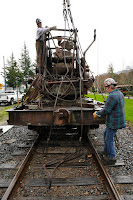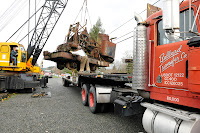 |
Steam crane is prepared
for shipment.
|
The Northwest Railway Museum has offered objects that are
outside its scope of collection or redundant to other museums. Over the last 20 years, more than a dozen
large objects have be sold or transferred to other institutions. And when other museums are not interested,
objects may be offered to a broader audience.
 |
Imhoff's 65 ton conventional crane
makes quick work of lifting the
circa 1903 steam crane.
|
Adaptive reuse is the process of retasking a building or object. It allows something that may have outlived its usefulness and repurposes it for something else. So an old school could become condominium housing. An old caboose could become a cottage or office. And a coal-fired steam crane could become the focal point of a new restaurant development where it supports an outdoor canopy.
 |
Jon Burget poses with
his new acquisition.
|
Snoqualmie’s own Imhoff Crane was hired to lift the vintage crane – all 45,000 pounds of it – and Seattle’s Ballard Transfer was hired to transport it. The move took most of a day and no doubt turned some heads on Interstate 90.
Congratulations to Jon Burget of Pavingstone Supply Inc on the
acquisition of this interesting historical object for his new restaurant. When he opens next summer, Spike will
broadcast the date, time and place so you can see adaptive reuse in
action!

2 comments:
Spike, Now that's something that you don't see every day! I certainly would have stared if I saw that being trucked on down the Interstate... Take Care, Big Daddy Dave
Thanks for the mention! Our vintage crane made it safely to it's new Ballard home.
Post a Comment